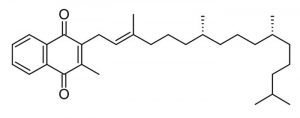Phytonadione Separation by Shape Selectivity
In this Method, we separate the two E and Z isomers of Phytonadione on the basis of shape selectivity. The below chromatogram is a five injection overlay with a resolution value of 1.5.


Peaks:
1. Impurity
2. Phytonadione (E isomer)
3. Phytonadione (Z isomer)
Method Conditions
Column: Cogent UDC-Cholesterol™, 4μm, 100Å
Catalog No.: 69069-15P
Dimensions: 4.6 x 150mm
Mobile Phase:
—A: 50% DI Water / 50% MeOH / 0.1% Formic Acid
—B: 97% Acetonitrile / 3% DI Water / 0.1% Formic Acid
Gradient:
| Time (minutes) | %B |
| 0 | 80 |
| 15 | 92 |
| 16 | 80 |
Temperature: 12˚C
Post time: 2 minutes
Flow rate: 1.5mL / minute
Detection: UV @ 254nm
Sample Preparation:
—Stock Solution: 10μL / mL Phytonadione in Acetonitrile diluent. (The solution was vortexed for 10 minutes.)
—Working Solution: Stock solution was diluted 1:10 with Acetonitrile.
t0: 1.0 minutes
Note: Phytonadione (a.k.a. Phylloquinone, Vitamin K1) is a lipophilic vitamin that can be obtained in the diet from leafy green vegetables. It plays an essential role in blood clotting by acting as a cofactor for formation of coagulation factors II, VII, IX, and X. The letter designation for Vitamin K was based on the first letter of “Koagulationsvitamin” (coagulation vitamin), which is from the German journal that first published its identification by Danish biochemist Henrik Dam.
Attachment
No 152 Vitamin K Isomers Analyzed with HPLC pdf 0.8 Mb Download File


